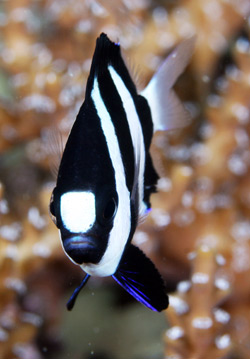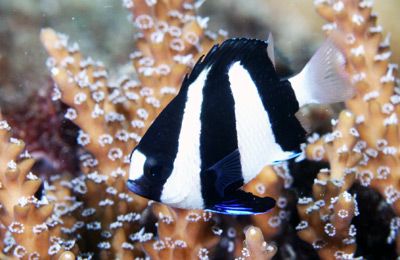There’s a reason I chose to spotlight Dascyllus aruanus, the humbug or three-striped damselfish, in this profile. “Caribbean” Chris and I will soon be matching wits with four representatives of this species that have laid claim to a large marine aquarium situated in one of our local coffee shops. Steve, the shop’s owner, is at wits’ end with these four humbugs, which won’t abide most new tankmates, and would like to see them captured and relocated by any means necessary, short of (or possibly including) dynamiting the tank.
Chris and I figure that between the two of us, we should have the mental prowess to outsmart these little devils, so we’re currently brainstorming the capture techniques we’d like to experiment with over the next week or so (suggestions from fellow salties are most welcome). We plan to document the process on video, so stay tuned for updates.
For the time being, though, let’s take a closer look at our future quarry:
Physical traits

D. aruanus, an Indo-Pacific species, is white overall with three vertical black bars on its sides, one extending from the leading edge of the dorsal fin through the eye and to the mouth, another at mid-body, and a third just in front of the caudal peduncle. The pelvic and dorsal fins are also black. Maximum length for this species is around 4 inches—quite a respectable size for a damsel.
I should note that a very similar-looking Western Pacific species in the same genus, D. melanurus, is also commonly called the humbug damsel (or blacktail humbug). This damsel differs from D. aruanus in that it has a fourth black band on its tail. Also, the black coloration on its dorsal fin is interrupted by white at mid-body instead of being continuous. Size-wise, this species is a bit smaller at around 3 inches.
In addition to looking very similar, these two species are much the same from the standpoint of behavior and care requirements, so everything said here regarding D. aruanus can generally be applied to D. melanurus as well.
Feistiness
Hobbyists often buy humbug damsels in groups when they’re still young, cute, and relatively peaceful (the damsels, not the hobbyists), but, as with so many damsel species, those adorable juveniles eventually transform into highly belligerent, territorial adults that are poorly suited to the average community aquarium. Any tankmates chosen need to be large and assertive enough to shrug off the humbug’s aggression. Also, while humbugs may share branching stony coral heads in nature, they often won’t tolerate conspecifics in the same aquarium beyond the juvenile stage.
Feeding
There’s no challenge here whatsoever. D. aruanus will readily accept most standard aquarium fare. Offer this omnivore a variety of small meaty and algae-based foods, and offer several small meals per day rather than a single large one. This species will even readily accept dry flake and pellet foods, like New Life Spectrum, which Chris and I both feed to our fish and heartily endorse.
Housing and reef-friendliness
I would consider a 30-gallon tank to be minimum housing for D. aruanus, but keep in mind that a larger tank will be necessary if you plan to keep an adult of this species with suitable tankmates.
On a positive note, while D. aruanus may become belligerent toward many other fishes sharing its space, this species is completely inoffensive toward sessile invertebrates and, therefore, a safe choice for reef systems.



